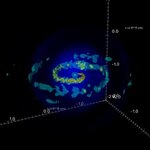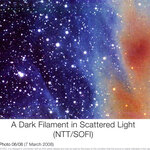Space

Astronomers using data from NASA’s Chandra X-ray Observatory, the Gemini Observatory and ESA’s XMM-Newton Observatory have made the best determination of the power of a supernova explosion long after it was visible from Earth.
By observing the remnant of a supernova that occurred about 400 years ago and a light echo from the initial explosion, the teams have established the validity of a new method for studying a type of supernova that produces most of the iron in the universe. The researchers studied the supernova remnant and the supernova light echo that are located in the Large Magellanic…

As Georg von Hippel wrote about here, a powerful stellar explosion detected March 19 by NASA's Swift satellite has shattered the record for the most distant object that could be seen with the naked eye.
The explosion was a gamma ray burst. The Very Large Telescope in Chile and the Hobby-Eberly Telescope in Texas measured the burst's redshift at 0.94. A redshift is a measure of the distance to an object. A redshift of 0.94 translates into a distance of 7.5 billion light years, meaning the explosion took place 7.5 billion years ago, a time when the universe was less than half its current age…

Located at the University of Utah, the High Resolution Fly's Eye (HiRes) is an experiment to study the highest energy cosmic rays to determine the energy, direction, and chemical composition of the incident particle.
Final results show that the most energetic particles in the universe rarely reach Earth at full strength because they come from great distances, so most of them collide with radiation left over from the birth of the universe.
The findings are based on nine years of observations at the now-shuttered observatory on the U.S. Army’s Dugway Proving Ground. They confirm a 42-year-old…

Life on another planet? No, it's far too hot on HD 189733b for that, but the Hubble Space Telescope's first ever detection of an organic molecule in the atmosphere of a planet orbiting another star is big news. It's an important step in eventually identifying signs of life on a planet outside our Solar System.
Hubble found the tell-tale signature of methane in the atmosphere of the Jupiter-sized extrasolar planet HD 189733b. Under the right circumstances, methane can play a key role in prebiotic chemistry – the chemical reactions considered necessary to form life as we know it. Although…

Amino acids are organic molecules that are the backbone of the proteins that build many of the structures and drive many of the chemical reactions inside living cells. The production of proteins is believed to constitute one of the first steps in the emergence of life. Amino acids are truly the 'building blocks' of life on Earth but the presence of these compounds in meteorites has led some researchers to look to space as a source.
Scientists at the Carnegie Institution have discovered concentrations of amino acids in two meteorites that are more than ten times higher than levels previously…

In a find that sheds light on how Earth-like planets may form, astronomers this week reported finding the first evidence of small, sandy particles orbiting a newborn solar system at about the same distance as the Earth orbits the sun.
"Precisely how and when planets form is an open question," said study co-author Christopher Johns-Krull, assistant professor of physics and astronomy at Rice University. "We believe the disk-shaped clouds of dust around newly formed stars condense, forming microscopic grains of sand that eventually go on to become pebbles, boulders and whole planets."
In…

If participants in the Dark Ages Lunar Interferometer study have their way, a telescope on the moon will allow astronomers to see 'back in time' and study the young Universe during the first 100 million years of its existence.
Although the night sky is filled with stars, these stars did not form instantaneously after the Big Bang. There was an interval, now called the “Dark Ages,” in which the Universe was unlit by any star.
The most abundant element in the Universe, and the raw material from which stars, planets, and people are formed, is hydrogen. Fortunately, the hydrogen atom can produce…

Astronomers at the University of Rochester have announced that low-mass stars and possibly even super-Jupiter-sized planets may be responsible for creating some of the most breathtaking objects in the sky.
The news is ironic because the name “planetary” nebula has always been a misnomer. When these objects were discovered 300 years ago, astronomers couldn’t tell what they were and named them for their resemblance to the planet Uranus. But as early as the mid-19th century, astronomers realized these objects are really great clouds of dust emitted by dying stars.
Rochester researchers now say…

Astronomers using ESO's New Technology Telescope have measured the distribution of mass inside a dark filament in a molecular cloud with an amazing level of detail and to great depth, based on a new method that looks at the scattered near-infrared light or 'cloudshine.'
Dark clouds are feebly illuminated by nearby stars. This light is scattered by the dust contained in the clouds, an effect dubbed 'cloudshine' by Harvard astronomers Alyssa Goodman and Jonathan Foster. This effect is well known to sky lovers, as they create in visible light wonderful pieces of art called 'reflection nebulae…

Astrophysicists are having a heated debate over the wave structure of the Sun’s Corona - a debate which may one day influence solar weather forecasting and the theory behind fusion reactors. The Sun’s core is about 6000 degrees C, but its outer layer, the Corona, which is filled with a strong magnetic field, is 200 to 300 times hotter.
Last year American scientists thought they had cracked this paradox with research showing how high-energy Alfvén wave structures could super-heat the Corona.
The astrophysicists said they could detect Alfvén waves within the Corona – waves that have a…